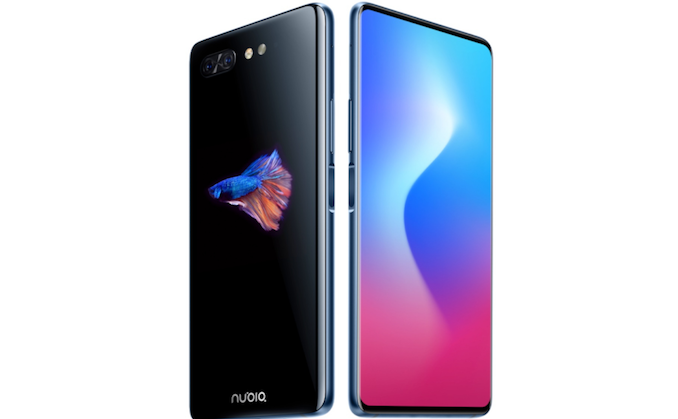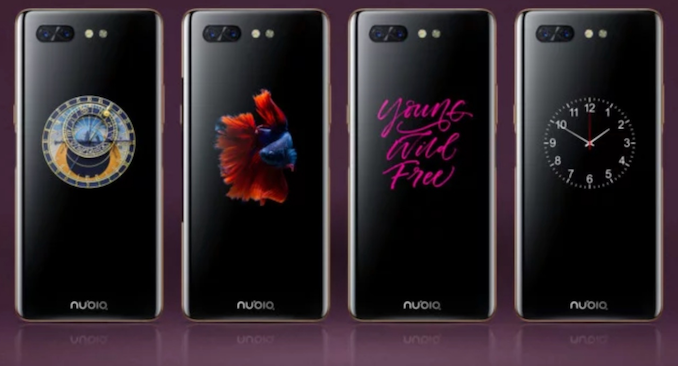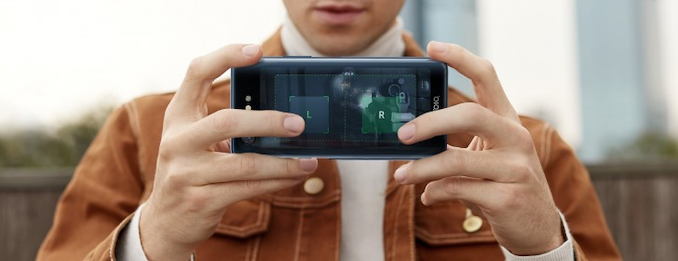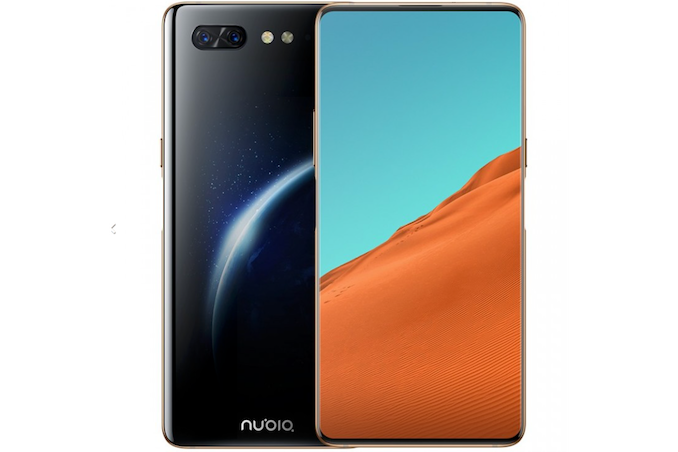Nubia X: a Dual-Display Smartphone with No Selfie Camera
by Anton Shilov on October 31, 2018 2:30 PM EST- Posted in
- Smartphones
- ZTE
- Nubia
- Snapdragon 845
- Nubia X

Nubia, a ZTE brand, this week introduced its new range-topping smartphone outfitted with front and rear displays and Qualcomm’s high-end SoC. The new Nubia X features a rare 93.6% screen-to-body ratio on the primary LCD, maximizing its screen real estate while also offering a serious performance. The phone will certainly catch some eyes, but what remains to be seen is how useful the second display is and how will it affect battery life of the device.
Impressive on the Outside
The two screens are naturally the key selling point of the Nubia X. The primary display is a 6.26-inch IPS LCD offering a 2280×1080 resolution, a 19:9 aspect ratio, and featuring no notch (as there is no camera). The secondary display is a 5.1-inch OLED that has the same aspect ratio, but a 1520×720 resolution. The screen on the rear of the smartphone blends with the device’s aluminum body and is designed primarily for ultimate personalization (e.g., you can load your own unique wallpaper on the back and get a handset no one else has). To make selfies as the Nubia X does not have a front-facing camera, but users will use the main camera and the rear screen to do so.
Speaking of the body, the Nubia X features a CNC-machined frame with Deep Gray, Black Gold, or Sea Light Blue finishes. The chassis has two side-mounted fingerprint readers, so the phone can be activated from either of its “sides”. It is noteworthy that despite packing two displays, the Nubia X is neither thicker or heavier than competitors. The phone has an 8.4-mm z-height and weighs 181 grams.
Powerful Inside
The smartphone is based on Qualcomm’s Snapdragon 845 SoC that integrates eight general-purpose Kryo 385 cores running at 1.80-2.65 GHz, the Adreno 630 GPU, a 64-bit LPDDR4X memory controller, Qualcomm’s X20 LTE modem, and so on. Right now, the S845 is Qualcomm’s flagship SoC for smartphones, so from processing and general features point of view, the Nubia X is on par with its competitors from other companies. The SoC is paired with 4 or 8 GB of LPDDR4X memory as well as 64 or 128 GB of storage. Interestingly, Nubia claims that it uses graphene layers too cool down the key electronic components of the Nubia X.
As for the battery, the handset is equipped with a 3,800 Li-Po battery, which is in line with battery capacity of top-of-the-range smartphones from other makers. Meanwhile, one has to keep in mind that the Nubia X has second screen and therefore consumes more than competing devices. Even though OLEDs do not consume a lot of power, they still do consume some, so it will be interesting to see how long will the Nubia X live on one charge.
When it comes to imaging capabilities of the Nubia X, they are limited to the back-facing dual camera setup. The primary camera comprises of a 24 MP sensor with an f/1.7 aperture, followed by a 16 MP sensor with a f/1.8 aperture, and a dual-LED dual-tone flash (one of the LEDs is a soft light one). As noted above, the camera is designed to be used both for regular and for selfie photos. The latter will clearly benefit from an advanced flash and high-performance sensors, so the Nubia X could become popular among those interested in selfies. Nubia claims that its camera software can detect scenes and environments to adjust settings, but does not elaborate.
Next up is connectivity. The smartphone supports modern 4G/LTE networks, 802.11ac Wi-Fi, and Bluetooth 5.0 on the wireless side of things. As for physical interfaces, the Nubia X has a USB Type-C port for charging, but no 3.5-mm jack for headsets.
Nubia will ship the X with Google Android 8.1 OS and its own Nubia 6.0 UI.
| General Specifications of the Nubia X | |||
| Nubia X 6 GB + 128 GB |
Nubia X 8 GB + 256 GB |
||
| Display(s) | Size | 6.26 inches + 5.1 inches | |
| Resolution | 2280×1080 (19:9) + 1520×720 (19:9) | ||
| PPI | 403 PPI + 330 PPI | ||
| Cover | Gorilla Glass 3 | ||
| SoC | Snapdragon 845 4 × Kryo 385 Gold @ 2.65 GHz 4 × Kryo 385 Silver @ 1.80 GHz |
||
| GPU | Adreno 630 | ||
| RAM | 6 GB LPDDR4 | 8 GB LPDDR4 | |
| Storage | 64 GB | 128 GB | |
| Networks | GSM GPRS (2G), UMTS HSPA (3G), LTE (4G) CAT 18/13 (DL/UL) Peak Download Speed: 1.2 Gbps Peak Upload Speed: 150 Mbps |
||
| SIM Size | Nano SIM | ||
| SIM Options | Dual SIM | ||
| Local Connectivity | Wi-Fi 802.11ac, BT 5.0 USB Type-C |
||
| Front Camera | none | ||
| Rear Camera | 24 MP sensor with an f/1.7 aperture with PDAF 16 MP sensor with a f/1.8 aperture with PDAF Dual-LED dual-tone flash (one of the LEDs is a soft light one |
||
| Battery | 3,800 mAh | ||
| Dimensions | Height | 154.1 mm | 6.07 inches | |
| Width | 73.3 mm | 2.89 inches | ||
| Thickness | 8.4 mm | 0.33 inches | ||
| Weight | 181 grams | 6.8 ounces | ||
| Launch OS | Android | ||
Nubia will start sales of the X in early November in China with availability in other countries following a bit later. The version equipped with 6 GB of RAM and 64 GB of storage will cost around $470 in China, whereas the flavor accommodating 8 GB of RAM and 128 GB of storage will be priced at approximately $600.
Related Reading
- ZTE is Back: The Axon 9 Pro at IFA 2018
- ZTE Announces The Blade V8 Mini And Blade V8 Lite
- ZTE's CSX "Hawkeye" Concept Phone Detailed, Kickstarter Launched
- ZTE Announces Blade V8 Pro with Snapdragon 625, Hawkeye Phone
- MWC 2018: ZTE Blade v9 Live Blog (3pm UTC, 10am ET)
Source: Tom’s Guide, GSM Arena, AndroidCentral














45 Comments
View All Comments
nathanddrews - Wednesday, October 31, 2018 - link
You know what the next step is, right? Cameras and screens on both sides. LOLToTTenTranz - Wednesday, October 31, 2018 - link
And notches.Lots of notches.
Yojimbo - Thursday, November 1, 2018 - link
The welfie! You take a pic of yourself and what you are looking at at the same time. You show yourself reacting to what you see.dshess - Wednesday, October 31, 2018 - link
AND, you probably can't put a case on that, so you'll need a replacement sooner!wolrah - Wednesday, October 31, 2018 - link
I've had smartphones since the original iPhone and never had a case. All of my phones have their fair share of dings and dents, but never any significant damage that actually affects usability.I know people who break phones all the time, even in cases.
What that tells me is it's a user problem and some people really just need to learn how to hold on to their phone better or not to put it in precarious places.
JoeyJoJo123 - Wednesday, October 31, 2018 - link
^ This.It's just clumsy, stupid people. They're paying their stupid tax when this stuff happens.
Sunrise089 - Wednesday, October 31, 2018 - link
Agree. People freak out when they see my bare phone. My first smartphone was an iPhone 3G. I dropped it and cracked the screen and told myself ‘gotta be more careful.’ I’ve gone the last decade with no case and no phone damage.I don’t begrudge anyone who wants a case for whatever reason makes sense to them, but suggestions that cases are necessary to prevent phone damage are bogus.
mkaibear - Thursday, November 1, 2018 - link
All my phones since the feature phone days have had a case, and so they haven't had any dings or dents. Which means that for a one-time investment of about a tenner for each phone I've "earned" way more than that on the resale value.Not putting them in a case and letting them accumulate damage is most definitely a fool's bargain.
jabber - Thursday, November 1, 2018 - link
I like a case on my phones purely because it adds weight and some 'heft' to it. Makes it feel more for the money.ajp_anton - Wednesday, October 31, 2018 - link
Sure you can attach the case to the side of the phone. The case would act as the two covers of a book, but with a phone in the middle instead of all the pages. Just flip between the first and last "page" of the book to switch sides on the phone.